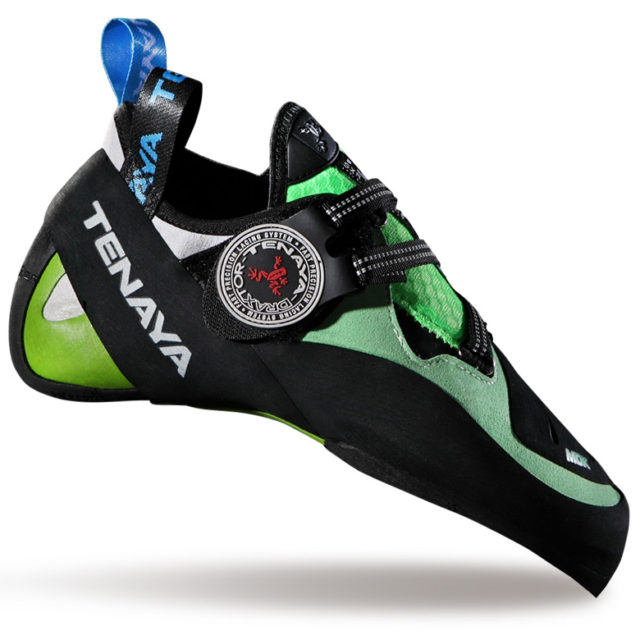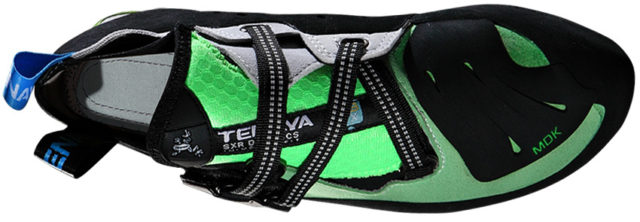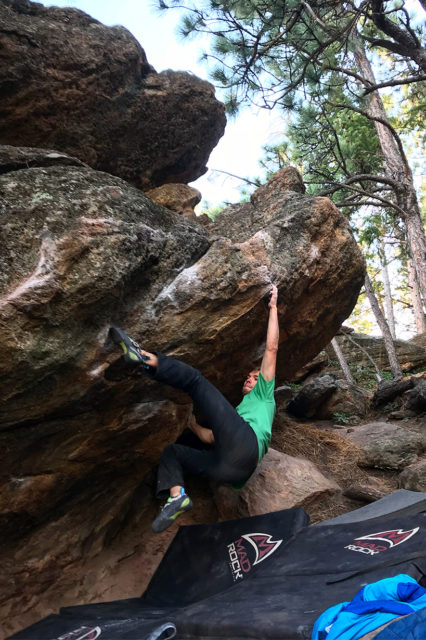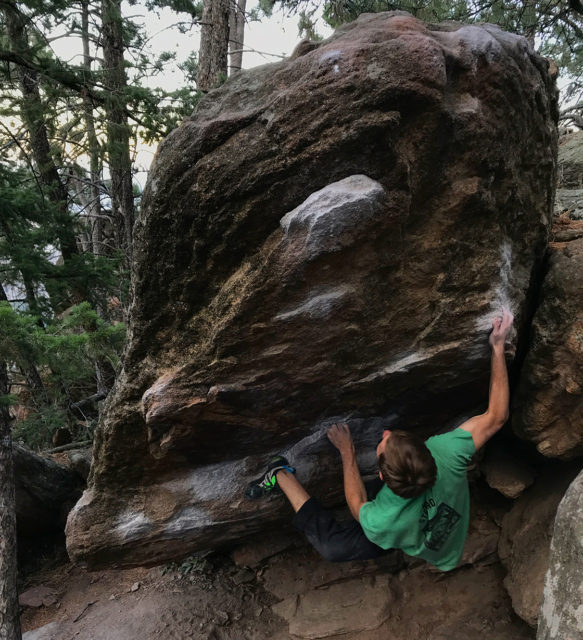
Tenaya Mundaka
Size Tested: US M’s 7.5 (EU 40.0)
Available Sizes: US M’s 4-14; US W’s 5-15
Construction:
- Upper: Leather microfiber with perforated lycra tongue
- Inner: Cotton with TXT treatment
- Insole: 2D multi-layer stretch tex
- Midsole: Double midsole GX 1.4 + TST 131
- Outsole: Vibram XS Grip 3.5 mm
- Closure: Velcro, Draxtor PAT system
MSRP: $180
Test Locations: Morrison, Flagstaff Mountain & The Satellites, CO; Moe’s Valley & Joe’s Valley, UT
Days Tested: ~15 days of outdoor bouldering; ~20 days of indoor gym use
Intro
The Mundaka is the newest addition to Tenaya’s aggressive-fit, “Aerial Plus” line of shoes, and stands as a softer, bouldering-oriented shoe in the brand’s lineup. Tenaya says the Mundaka is significantly softer and thinner in the midsole than their previous models, which is meant to increase performance for steeper climbing, and puts the Mundaka in the same class as other softer shoes like the La Sportiva Skwama and Scarpa Chimera.
However, the Mundaka also has a slightly wider toe box than Tenaya’s other high-performance shoes. As a result, the Mundaka’s supposed performance boost on steep terrain is also said to come with an increased level of comfort.
As someone who has spent my climbing career cramming my feet into uncomfortable footwear, I was very interested to see if I’d find this to be true.
Here’s what Tenaya says about the Mundaka:
“The perfect combination of form and flexibility enabling ultimate precision. The Mundaka features a close, glove-like fit, providing maximum responsiveness in all types of climbing situations. Aggressive yet balanced, the Mundaka is the widest-fitting shoe in the Tenaya’s toe-down range and is superbly capable on overhanging routes and boulder problems, while losing no efficiency on lower-angle smearing.”
Last and Geometry
Similar to other shoes in Tenaya’s “Aerial Plus” high-performance line, the Mundaka has a slightly less aggressive shape than comparable shoes from other brands (e.g., Five Ten Team or Evolv Nexxo), and the Mundaka lacks the very steep downturn that seems to be otherwise commonplace in this category.
The Mundaka does bend down from the arch of the foot, but the toe box itself is fairly flat. Far from being a hindrance, I found this profile to be much more versatile than other, more drastically downturned shoes. The Mundaka has just enough downturn to toe-in during horizontal roof sections, but the flatter toe box allowed the shoe to maintain a high level of friction on smeary or slabby features.
As advertised, the front of the Mundaka does feel slightly wider than other Tenaya models such as the Tarifa or Oasi (those two shoes felt much more constrictive around my toes). I’ll cover the benefits of the Mundaka’s last and geometry in greater detail in the Performance section.
Size & Fit
As always, we recommend trying on shoes to see how they’ll work for your feet. But with that said, I can comment on my own experience with the Mundaka.
I will start off by saying that I’ve found the Mundaka to be incredibly comfortable, much more so than other aggressive shoes I’ve used. That being said, I had to downsize dramatically to get the performance fit I was looking for. The Tenaya website recommends going down a full size from your street shoe for all of their more aggressive models, but I ended up dropping two and a half sizes before finding the performance fit I wanted. Part of this is probably due to the softer nature of the shoe, which has allowed it to conform more to my foot. However, even with significant downsizing, the shoe stretched more than I expected over the course of my testing period. While the shoe is primarily synthetic, it still ended up stretching about ¼ of a size, which I suspect is due to the softer rubber.
So, I definitely recommend that you try on the Mundaka before purchasing.
Vibram XS Grip Rubber & Construction
Nearly all of Tenaya’s shoes (including the Mundaka) use the older Vibram XS Grip rubber, instead of the XS Grip2 found in the La Sportiva and Scarpa lines. This was my first time using the XS Grip rubber compound and I found it to be much softer and more malleable than the XS Grip2 rubber I’d used on other shoes. In this way, the XS Grip rubber on the Mundaka seemed more similar to the 5.10 Stealth HF rubber used on the Team shoe. The rubber on the Mundaka feels incredibly sensitive, and allowed me to bend my feet and dig in with my toes during steeper climbing. The Mundaka’s XS Grip rubber doesn’t seem quite as durable as firmer rubber compounds, but that is largely to be expected with softer compounds.
The Mundaka has a larger rubber patch over the toe box than other Tenaya models, which is meant to increase performance in toe hooks and scums. This extra rubber was especially useful when paired with the shoe’s flatter profile and thinner midsole, as it allowed me to bend my toes and foot backward to further engage the rubber section and provide maximum friction during toe hooks and scums.
The Mundaka’s inner lining and perforated lycra tongue make it incredibly comfortable and easy to slip on. The construction and overall quality of the Mundaka feels similar to that of many La Sportiva shoes.
The Mundaka’s Draxtor PAT closure system did its job well, working well for various foot shapes and climbing needs (I had several people with the same shoe size try on the Mundaka at the gym I work at and all of them were able to achieve a good fit). The Draxtor PAT system is similar to the closure system found on the La Sportiva Solution and Futura, but the Mundaka has an extra lace eyelet and lets you tighten the lower and upper individually, allowing for more customization.

Performance / Who’s It For?
The Mundaka is an excellent high-performance bouldering shoe that excels in overhung terrain, on glassy feet, and occasional slabby sections. The shoe’s overall shape and the flatness of the toe box add precision and power to the toes, aiding in steeper edging scenarios.
For example, the Mundaka was the perfect shoe when I was working Captain Hook, a problem up at the Satellite Boulders in the Flatirons. That boulder problem works through tiny slopey feet in a roof, and finishes with a double toe hook move. The Mundaka felt solid toeing in to the small feet, and the rubber stuck well. When it came to the toe-hook, I was able to really pull back with my foot, securing the shoe while I moved through the next section. I had previously had issues with this move while using other shoes, as the more downturned shape of my other shoes (e.g., the Evolv Nexxo) made it harder to engage the toe-hook.

When it comes to vertical and less-than-vertical terrain, the Mundaka is passable, but this terrain isn’t the Mundaka’s forte. The shoe is just a bit too soft to put a lot of weight on micro edges. If vertical edging is what you’re after, other shoes like the Tenaya Tarifa or the La Sportiva Otaki would perform better.
I’d also add that I think the Mundaka could be an excellent choice for the modern competition climber, as the flat forefoot provides excellent traction on the increasingly popular volume problems throughout the USA and World Cup series.
For me, the only major drawback of the Mundaka revolves around the heel. The heel material is soft, which I generally like, but the overall shape, incut, and angle of the heel tension band isn’t very steep (as opposed to a shoe like the Five Ten Team). The Mundaka’s heel construction and shape led to very insecure-feeling heel hooks, where no matter how much downsizing I did, it always felt like my heel was on the verge of blowing off during more strenuous moves.
While it might seem as though the soft heel material is solely to blame, I think it’s the combination of the soft material and the shape that make the heel feel insecure. For example, the La Sportiva Testarossa also has a soft heel, but the Testarossa is the best heel-hooking shoe I’ve used. The Mundaka’s lack of stability in heel hooks was enhanced by the shoe’s natural stretch, and got worse over the testing period. With all that said, heel shape is highly personal and may fit / feel different on another individual’s foot.
Comparisons
While often compared to other soft bouldering shoes like the Scarpa Drago, I actually found the Mundaka more similar to the Scarpa Instinct VSR, just way softer and with a less bulky heel cup. Both the Instinct VSR and the Mundaka aim to couple the edging performance of a stiffer forefoot with flexibility in the arch of the foot from a thinner midsole. This gave the Mundaka a level of versatility that an overall softer shoe like the Scarpa Drago lacks. While not ideal, the Mundaka performs better on vertical edging terrain than the softer Drago.

The front of the Mundaka felt similar to the old La Sportiva Python, in that it delivered good performance on overhung terrain, while still achieving a level of comfort not usually associated with aggressive climbing shoes. In this way, the Mundaka also felt similar to the 5.10 Hiangle. I’ve found both shoes to be fairly comfortable (though I would say the Mundaka is more so), and both do well as all-around aggressive bouldering or sport shoes. The Hiangle holds a bit more of a downturn shape than the Mundaka though, and is a bit stiffer through the midsole.
Bottom Line
The Tenaya Mundaka offers an excellent blend of performance and comfort, and I think it excels as a steeper bouldering and competition shoe. It is a great option for intermediate to advanced level climbers who use and depend on precise edging and footwork through overhung sections. Like all shoes, the Mundaka doesn’t perform well in every area, and if longer duration vertical edging (e.g., a place like Smith Rock) or aggressive heel hooks are your priority, you may want to look at different options like the La Sportiva Otaki, Scarpa Booster S, or Evolv Shaman. But if you prioritize sensitivity, precise edging on overhung sections, toe hooking performance, and are looking for something with a bit of a wider fit than most other high-performance shoes, the Mundaka is definitely worth checking out.
